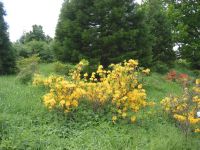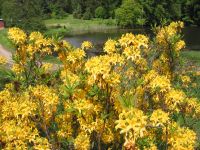common yellow azalea - Rhododendron luteum
English name:
common yellow azalea
Scientific name:
Rhododendron luteum
Family:
Ericaceae (heath family)
Height:
up to 3 M in our collection
Flowering:
Late May & June
Range:
Eastern Europe and Caucasus north to Poland
 |
|
 |
 |
The 45 year old Rhododendron luteum in the picture is from seed received from Arboretum Mlynany Bratislava, Slovak Republic. The plant pictured here can be found in the azalea collection adjacent to our Rhododendron Dalen: in square 2104, position 2938.
Plant description:
This months plant Rhododendron luteum is a dominate element in the arboretum in early June with its strong scent and brilliant yellow flowers. The scent can be detected dozens of meters from massive plantings, both of which create a lasting impression.
Rhododendron luteum belongs to section Pentathera within the genus Rhododendron. In this section leaves are alternate, stamens are 5 and the flower petals are densely hairy on the outer surfaces. All but two species within this section come from North America. One of the two exceptions comes from Eastern China and Japan, and the other (R. luteum) from Europe. This is Europes only azalea.
The flowering season of Rhododendron luteum is rather long for a rhododendron, because the flowers in each inflorescence open in succession. An attractive autumn leaf colour is also typically for the species. We have about 75 examples of
Rhododendron luteum in our collection in Hørsholm. But because of the massive dense plantings in a few areas it is difficult to count them all. Our oldest living plants came from the J. Madsen Nursery, in the town of Middelfart, Denmark, in 1952. Our documented, wild-collected specimens come from several places in the Caucasus, as well as from Greece and Turkey.
Rhododendron luteum was originally named Azalea pontica by Carl von Linne, was renamed Rhododendron flavum, and finally the given the name R. luteum in 1830. Sometimes the old names are stilled used. It has been grown in Denmark at least as early as 1831. It is grown in much of Europe as a garden plant and has naturalized in Britain but is not reported to be a problem there in contrast to R. ponticum. In its native range it can be a difficult weed that spreads with underground runners invading and reducing the productivity of pastures.
These are vigorous deciduous upright shrubs that can spread by underground runners. The oblong leaves are 5 to 15 cm long and 1.5 to 4 cm wide. The upper and lower surfaces are pubescent at first, but later they are hairless except for a few sticky hairs. They often have fine autumn leaf colours in red, and orange. Young twigs and flower stalks can also have sticky hairs. The flowers open before or at the same time as the leaves and open in succession within a given inflorescence. This later trait is variable in our collection, with some plants opening their flowers more or less simultaneously and other over a longer time. The petals form a funnel-shaped flower with sticky hairs on the outside. They are bright yellow with a darker blotch and strongly fragrant. Occasionally orange coloured flowers are reported. It is distinguished from its close relative R. austrinum by having a shorter flower-tube and by the strong scent and the fact that it grows in eastern Europe and western Asia.
This is an excellent garden plant for Denmark. Flowering is reduced in strong shade and the plants under densest shade in our collection produce no flowers at all. Pictures from its native range indicate it often grows on open slopes. Because it spreads by runners, it is possible to regenerate exact copies of especially desirable mother plants. However, it also produces abundant viable seed and is more often regenerated by seed. Because of the ease of regeneration it is often used as understock for grafting. Soon after its introduction it was used to produce numerous early hybrids.
References:
Bean, W.J. 1976 Trees and Shrubs Hardy in the British Isles Vol III. N-Rh. Bean and Murray publishers. 973 pp.
Cox, P.A. 1990. The Larger Rhododendron Species. B.T. Bratsford Ltd. London 389 pp.
Cox, P.A. & Cox, K.N.E. 1997. The Encyclopedia of Rhododendron species. Glendoick Publishing, Perth Scotland. 396 pp.
Davidian, H.H. 1995. The Rhododendron Species. Vol IV. Azaleas. Timber Press Inc. Portland. 184 pp.
3Jørgensen, Per M. 2003. Rhododendron i det norske arboret på Milde. 2nd addition, Vigmostad & Bjørke AS, Bergen. 264 pp.
